How to Roast Chestnuts in the Oven
Roasted chestnuts are one of the great pleasures of autumn and winter. Their sweet, nutty aroma fills the kitchen, while their soft, tender flesh makes for a warming seasonal treat.
Whether enjoyed as a simple snack, served as a festive side dish, or used in desserts, roasted chestnuts bring a touch of rustic comfort to the table.
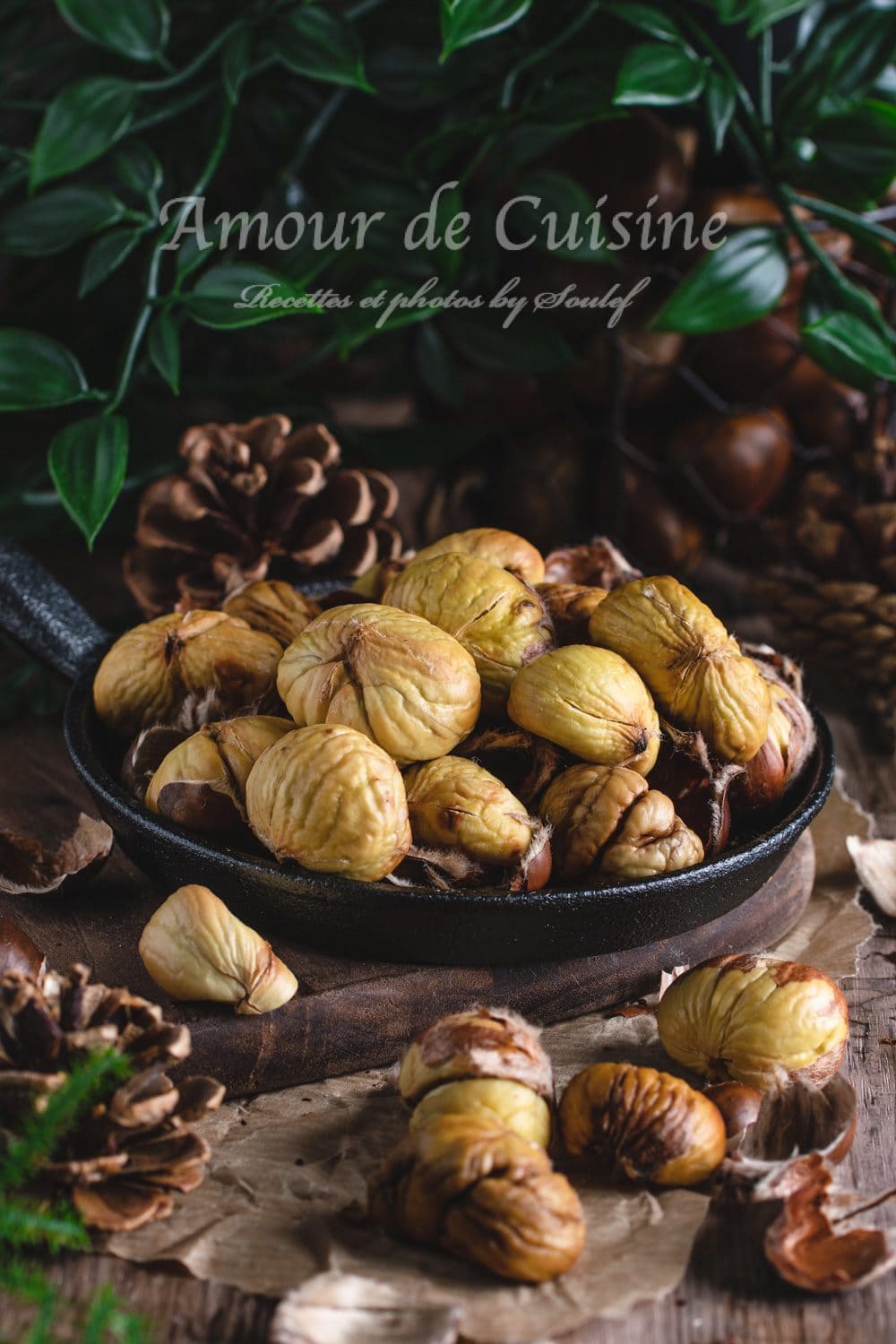
Easy Roasted Chestnuts in the Oven Recipe
There’s something magical about roasting chestnuts the old-fashioned way, crackling over glowing embers in a fireplace or sizzling on a perforated pan above an outdoor barbecue.
I do remember my mum laying them directly on the heavy lid of a cast-iron stove, letting the shells split open as the sweet aroma filled the room.
These traditional methods create an unbeatable smoky flavour, but let’s be honest, not everyone has a fireplace or a chestnut pan tucked away in their kitchen.
That’s where the oven comes to the rescue. Roasting chestnuts in the oven is simple, practical, and wonderfully rewarding.
With a hot oven and the right timing, you’ll achieve chestnuts that are tender, sweet, and golden, without the risk of them turning tough.
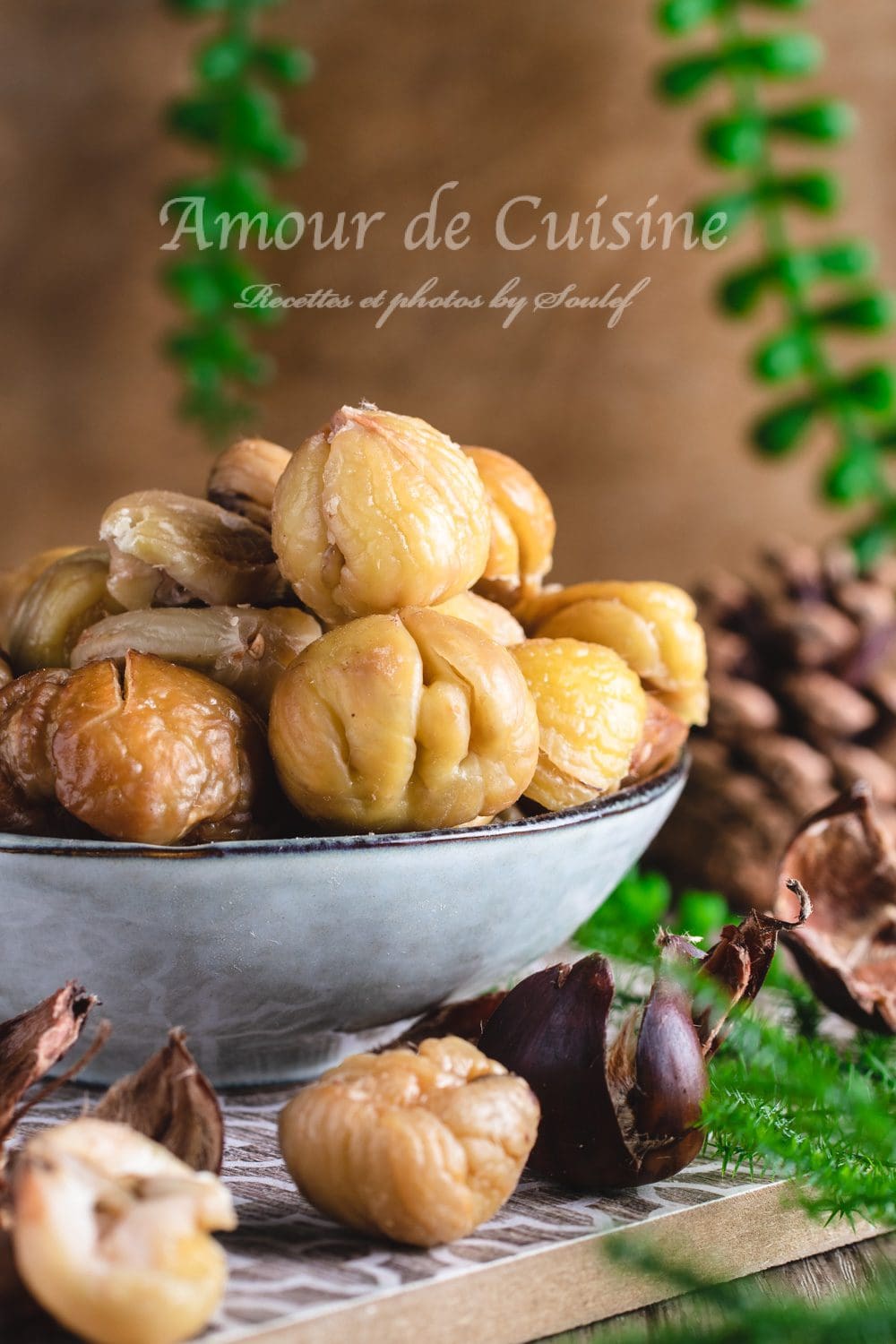
Boiled Chestnuts or Oven-Roasted Chestnuts?
For me, nothing will ever beat my mother’s method, roasting chestnuts on the thick, cracked lid of our old oil stove. The aroma would fill the whole house, marking the true taste of winter.
Traditionally, the best way is still over hot embers, whether in a fireplace or on an outdoor barbecue. Another option is roasting them on a gas stove using a perforated iron pan, designed so the flames can lick the shells and give them that unmistakable flavour.
But if, like me, you don’t have a special pan or gas burner, the oven is a fantastic alternative. Just make sure it’s preheated well, and don’t overcook them, otherwise they’ll turn hard. The result comes very close to fire-roasting.
I often boil chestnuts when I need them for other recipes, like candied chestnuts or chestnut cream. They’re delicious eaten warm just as they are.
Still, I have to admit roasted chestnuts win every time: sweeter, more fragrant, and with that lightly crisp texture that makes each bite irresistible.
Roasted chestnuts are perfect as a winter snack or a little indulgence after dinner. They also shine in festive poultry stuffings, elegant desserts, or even in simple sides like roasted Brussels sprouts.
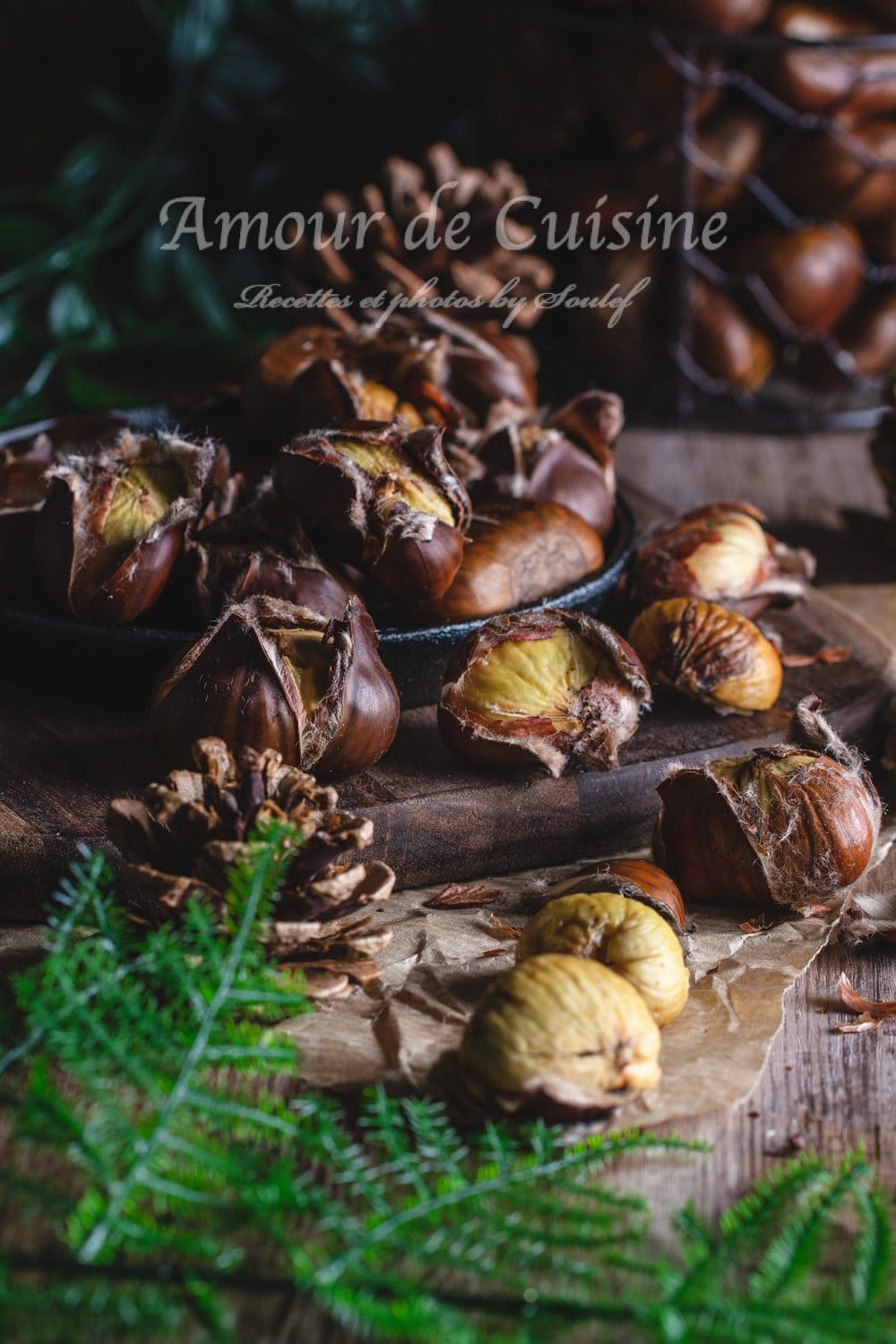
How to Choose the Best Chestnuts and Store Them
– When buying chestnuts, look for ones that are glossy, free of blemishes, firm to the touch, and feel heavy for their size. These are the signs of freshness.
– Test their quality with the float method: place chestnuts in a bowl of water, those that float are no good and should be thrown away immediately.
– Peel them while warm for easier handling. If you’ve cooked a large batch, you can peel and refrigerate them for a day or two. Cooked and peeled chestnuts also freeze well.
– Use them quickly. Try to roast or cook chestnuts within 2-3 days of purchase, as their freshness fades fast, even in the fridge. Discard any that are mouldy or spoiled.
– Storage : keep them in a cool, dark place for a few days, or in the fridge for up to a week. For longer storage, freeze raw chestnuts after scoring them.
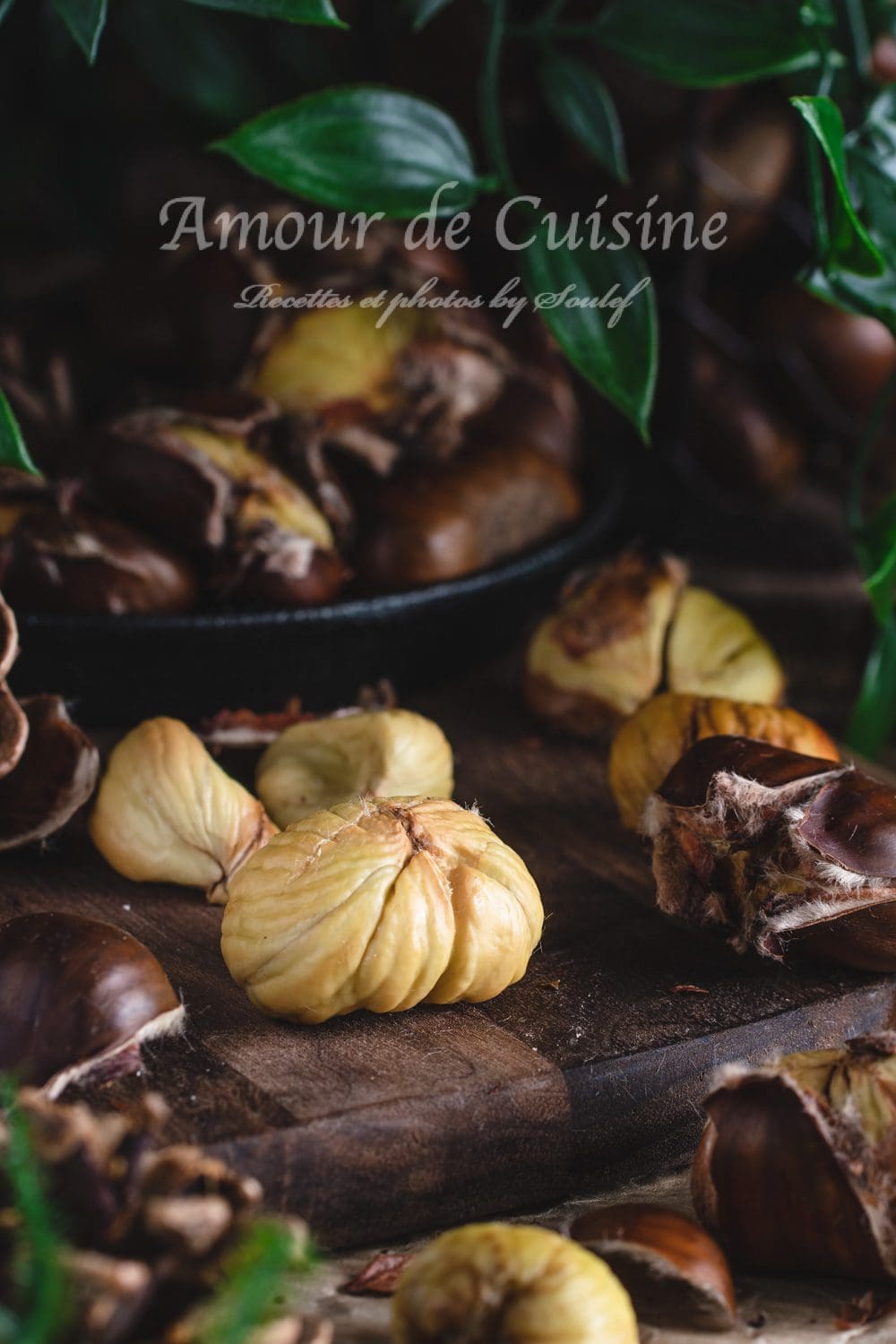
Step-by-Step Recipe for Perfect Roasted Chestnuts
- Rinse the chestnuts : Place them in a colander and wash under cold running water. Drain well.
- Score each chestnut : Place the flat side down on a cutting board, rounded side up. Using a sharp knife, make a horizontal slit, then rotate 90° and cut a second slit to form an “X”. Avoid cutting into the inner skin.
- Soak : Transfer to a bowl, cover with cold water, and soak for 1 hour. This softens the shells and makes peeling easier.
- Preheat the oven : Heat to 220°C / 425°F. Drain the chestnuts (no need to dry them) and spread in a single layer on a baking tray.
- Roast : Bake for 25-30 minutes, turning if needed. They are done when the shells curl open and the flesh is tender.
- Steam to loosen skins : Remove from the oven and wrap in a clean towel (or place in a paper bag). Close tightly and let rest 10-15 minutes. The trapped steam helps separate the shells.
- Crack and peel : Press gently through the towel to loosen shells, you’ll hear them crackle. Peel while still warm, removing both the outer shell and the thin papery skin.
- Serve : Enjoy them plain, or season with salt, herbs, or spices.
Variations and Flavour Twists
- Spiced chestnuts : sprinkle with paprika, smoked salt, or rosemary before roasting.
- Sweet version : dust with cinnamon sugar or cocoa powder while warm.
- Stuffing : chop and combine with bread, onions, and herbs for a festive poultry stuffing, like this Roast Stuffed Turkey Recipe.
- Desserts : blend into cakes, muffins, tarts, or homemade chestnut cream.
- Mediterranean style : drizzle with olive oil and finish with flaky sea salt.
Serving Ideas
Roasted chestnuts are versatile. Here are some ways to enjoy them:
- As a winter snack : eat warm with mulled wine, tea, or hot chocolate.
- At the table : serve in small bowls as a cosy appetiser.
- With mains : add to roasted vegetables like Brussels sprouts, squash, or carrots.
- In salads : pair with arugula, pears, walnuts, and blue cheese.
- For holidays : use in turkey stuffing, risottos, or soups.
- Sweet finish : serve with ice cream, drizzle with melted chocolate, or use as pie filling.
Common Questions (FAQ)
– How do I reheat roasted chestnuts?
Warm them in the oven at 160°C (320°F) for 5 – 7 minutes, or gently in a covered skillet.
– Can I freeze roasted chestnuts?
Yes, peel them first and freeze in an airtight bag. Reheat from frozen in the oven.
– Why do my chestnuts turn hard?
They were either overcooked or not soaked before roasting. Reduce cooking time and always soak beforehand.
– Can I boil chestnuts instead of roasting them?
Yes, boiled chestnuts are softer and work well for purées, marrons glacés, and chestnut cream.
Nutrition and Benefits of Chestnuts
Chestnuts differ from most nuts: they are low in fat and rich in complex carbs, fibre, vitamin C, and antioxidants. They make a wholesome snack and a versatile ingredient for both sweet and savoury dishes.
Other appetiser recipes to try
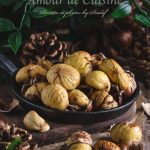
foolproof oven Roasted Chestnuts recipe
- Total Time: 40 minutes
- Yield: 500 g 1x
Description
Roasted chestnuts are one of the great pleasures of autumn and winter. Their sweet, nutty aroma fills the kitchen, while their soft, tender flesh makes for a warming seasonal treat.
Ingredients
- 500 g of chestnuts
Instructions
- Place them in a colander and rinse under cold running water. Drain well.
- Lay the flat side down on a cutting board, with the rounded side (the “belly”) facing upward.
- Hold the chestnut firmly and, using a sharp paring knife (or a chestnut knife), make a horizontal slit across the rounded side.
- Rotate the chestnut 90° and cut another slit to form a cross (X). Take care not to pierce the inner skin. Repeat with all chestnuts.
- Transfer the scored chestnuts to a bowl, cover with cold water, and soak for 1 hour.
- Heat to 220°C / 425°F. Drain the chestnuts (no need to dry them) and arrange in a single layer on a baking tray.
- Bake for 25-30 minutes, turning if needed. They are done when the shells open and the flesh is tender.
- Remove from the oven and wrap the hot chestnuts in a clean towel to form a bundle. Leave them to steam for 10-15 minutes. (Alternatively, place them in a paper bag, roll the top closed, and rest for the same time.)
- Press gently through the towel or bag to crack the shells, you should hear them pop.
- Transfer to a dish and peel while still warm, pulling back the scored “X”. Remove both the outer shell and the thin papery skin.
- If the inner skin clings, use the tip of a small knife to scrape it away, being careful not to damage the flesh. Discard any spoiled or rotten chestnuts.
- Enjoy roasted chestnuts plain, or season with herbs, spices, or a sprinkle of salt.
- Prep Time: 15 min
- Cook Time: 25 min
- Category: appetiser
Nutrition
- Serving Size: 100 g
- Calories: 200 kcal